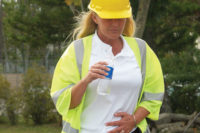 Are you tired of lessons and definitions of heat stress, heat exhaustion and heat stroke every summer?
Are you tired of lessons and definitions of heat stress, heat exhaustion and heat stroke every summer?
Don’t get me wrong, these are important topics for our employees to know and understand.
My concern is many of our employees are a little short on actionable information past the three definitions. For those of you who just can’t get enough here are some brief definitions so you won’t feel short changed by this article. But read past them; we’ll get to some meat and potatoes you can actually do something with.
Heat stress is a situation where too much heat is absorbed by a person and causes stress, illness or even death. Heat stress is manifested by elevated body temperature, hot, dry skin, and lack of sweating and neurological symptoms such as paralysis, headache, vertigo, heat cramps and unconsciousness.
Heat exhaustion occurs after overexposure to high heat. It is the more mild form of heat illness, and can progress to heat stroke if not treated.
A heat stroke refers to a medical condition where the body becomes overheated in a very short period of time. It normally occurs when the body fails to dispose of excess heat naturally. The condition normally requires urgent medical attention and can be life-threatening.
This article assumes that you have already covered these heat related illnesses (HRI) with your employees and could use some help on the implementation part of preventing them.
It is no longer acceptable to teach these concepts to our employees and tell them to “drink more water.” While this seems simple enough, our employees are often burning it at both ends during the heat of the summer. Merely having the knowledge they need to drink extra water and having it available doesn’t always mean that it is happening. Other real life factors come into play that the employee must learn to address proactively.
These “real life” factors include things like having had too much to drink (alcohol) the night before; enjoying that morning cup (or more) of coffee; coming to work already dehydrated from recreation or work at home; poor health conditions and just the fact that you can only drink so much water before it starts to taste bland.
The approach I’ve seen most organizations take is one of advocating for a “Heat Stress Program” for the warmer months. To most employees this is as valuable as telling them, “it’s going to get hot this summer.”
| The first step in getting the employee to be in tune with their “hydration meter.” They must...be able to do an assessment on their own personal health standing and their recent activities. |
Coupling the seriousness of the illnesses above and the multi-faceted aspect of each and every employee, we must initiate a much more personal and impactful approach to employee hydration. When we move the discussion from HRIs to individual hydration needs the impact can become a life changing strategy for employees.
The “Individual Hydration” concept starts with showing employees a common sense method of staying hydrated. One way of thinking about this is training each employee on how their own “hydration meter” works.
For example, a young, healthy, well-acclimated worker who has no medical issues, no drinks that were caffeinated nor alcohol in them from the night before starts the work day out with his/her “hydration meter” indicating the body is ready for work and needs “regular” hydration.
In contrast, an employee who is obese, has previously been in an office environment, partied hard in the sun the day before and start his/her day off with a double shot latte’ from the corner coffee shop starts the work day out with his/her “hydration meter” indicating the body is already at the breaking point and significant hydration is going to be necessary to function efficiently and avoid illness/injury.
These are two drastically different readings on the personalized “hydration meter.” Obviously, we cannot keep real time data on every employee’s “hydration meter.” But as safety and industrial hygiene professionals we must give our employees more tools than just telling them to drink more water.
When we only arm our employees with the basic HRI information and paint them a picture of drinking water from a fire hose; not only are they overwhelmed but they have no tangible representation of exactly what they are supposed to do. This is further compounded by the fact that water by itself can become bland or lose its taste or appeal when large amounts are being consumed. Don’t worry, this isn’t going to be an ad for any of the sport drinks, although they do play an important role.
The first step in getting the employee to be in tune with their “hydration meter.” They must know the HSIs as discussed above; but past that, employees needs to be able to do an assessment on their own personal health standing and their recent activities.
This doesn’t mean that anyone needs to stand up and tell everyone that they are obese and that they were out drinking last night. It does mean that the employees must consciously take readings on their current standing in respect to proper hydration. This must be done before they start work and are put in a HSI environment.
This can easily be facilitated first thing in the morning before employees begin their work task. Additionally, it helps if they create a visual gauge for themselves. For example the young, healthy employee above could start the day saying, “My hydration meter is level and I need normal hydration this morning.” In the same way the less fit employee above who was out partying would start the day by saying, “I have significantly taxed my body and I will need to consume more liquids than normal.”
Neither are a scientific measure, but both employees have consciously stopped and assessed their current hydration demands. That is paramount for proper hydration.
Secondly, the employees should have a measurable system for liquid intake. By that I mean, knowing I have to drink two of my large “stop and go” refill mugs before morning break is much easier to grab onto than knowing I have to drink 40 oz. before morning break. This is important-- not for knowing how many ounces have been drank -- as it is for allowing the employee to visualize the amount and monitoring their own progress.
Next, hydration needs to be a team effort. Hydration is facilitated better when everyone stops at the water cooler; when coworkers are asking their cohorts if they have had their necessary hydration; or when the task at hand is divided into drink breaks before the task is started. With this approach hydration becomes part of the job, part of the schedule. Thus it is more easily accomplished and not forgotten.
My organization has embedded hydration into the foreman’s daily activities. We keep sport drinks in pallet lots and made it available for all foremen to carry in their vehicles. As part of their rounds, part of their conversation is centered on giving the sport drink to the employees. The employees appreciate it, it helps with hydration, and it continually heightens the hydration message. And coincidentally, we found the employees are eager to see the foreman!
Since we have started this our heat related illnesses have been cut six fold. It goes without saying that this makes for a perfect opportunity to ensure how everyone’s “hydration meter” is doing. What we have found is the heightened awareness, added hydration contact by the foreman, and everyone watching their “hydration meter” has equated to far fewer incidents.
So don’t stop with just teaching the HISs, show the employees how to keep their “hydration meter” on the full side.


